Maker Profile: Bill Doran’s Punished Props
A longtime friend of Tested, Bill chats with us about his prop-making career and how he came to be known as the "Mass Effect Pistol Guy".
We have tremendous admiration for makers who find a way to turn their hobbies into their day jobs, especially when that means leaving an already stable career. That’s one of the reasons we’re fans of Bill Doran, who makes props as Punished Props. Even though Punished Props has only been Bill’s full-time job for under a year, he’s been extremely prolific and has created some really memorable pieces. We’ve known Bill for a while–Gary actually introduced us to him when he was looking for a set of custom Mass Effect armor. And if you watched our Octoberkast 24-hour podcast last year, you saw us auction off one of Bill’s custom Paladin pistol props for charity. We had it in the office for a few weeks and I didn’t want to let it go.
Even though he seems like a maker who never stops working (evident from the frequently-updated Punished Props facebook page), Bill took some time to share with us his prop-making background and current build process.
Let’s start off with your origin story, if you will. What was the first prop you made, and what were your skills at that point?
If I dig way back, I think the first prop that I built was a lightsaber. When I was 15 there was nothing I wanted more than to be a Jedi, and of course each Jedi must construct his own saber! It ended up being a dowel with some PVC pipe and a whole lot of different sized washers on it. If memory serves correct, the whole thing was held together (rather poorly) by an unholy amount of super glue. The project demanded only the most rudimentary skills; cutting PVC and dowel as well as gluing things together.
Walk us through, then, your growth as a prop builder. What were the new skills you learned with each prop you’ve made?
As I got older, I did a lot of craft type projects. We had a “hobby shop” in our basement where we constructed a lot of radio controlled vehicles with my dad. In that time I learned a lot more about cutting things out with power tools and assembling and painting finished pieces. I also took every single drafting, shop, and design class that my high school offered.
I went to college for 3D computer art, but the curriculum also included a lot of traditional 3D design and sculpture type of classes along with the 3D modeling and animation classes. This was an instrumental part of my learning more about creating finished pieces completely from scratch. Although I’m glad that I didn’t keep any of those finished art pieces, they are pretty terrible!
All of those skills came into play when I started building video game props for my convention costumes. Most recently I’ve gotten a lot of practice with techniques like using a lathe, mold making, plastic resin casting, and painting pieces to mimic in-game reference art. All of that has come through thousands of hours of failing, practicing and re-doing things until they are satisfactory.
When you come across a new challenge or required skill you don’t have, what are the resources you go to looking for guidance? Friends in the prop-making community? YouTube?
I find that looking up instruction videos on YouTube can be very useful. You tend to have to wade through a lot of not-so-useful videos, but there are some real gems on there. I also like to find any reference materials that materials suppliers produce. Both Tap Plastics and Smooth-On have extensive reference materials on using their products. I also have a Tap Plastics retail store nearby and will pick their brains whenever I’m there.
I also straight up try and duplicate the techniques that other prop makers are using. There is a growing trend for makers to share their techniques and methods on the internet and that has proven extremely useful for me. I always do my best to pay it forward for the next breed of makers. This is why I provide detailed build write-ups on my website whenever I finish a project!
The best, and most fun, method of procuring technique advice is from in-person interactions with other prop makers. There is nothing more fun than talking shop over some beers at Dragon*Con!
So what skills are you looking at learning next?
Since I have a very strong background in 3D computer art and modeling, I would really like to start 3D printing parts! My wife (also a talented 3D modeler) had a Mass Effect helmet printed at Shapeways and I was drooling over the resulting piece! The technology is getting to the point now where I could 3D print nearly all of the parts for a build and only really need to do clean-up, priming, and sanding before it is ready to go under some silicone for mold making.
I also want to get my hands on a milling machine to start making more functional parts out of metal. Most of my work now is done in plastic, but if I were to build something that needed to resist some high stress forces, I’d really need it to be metal. Also, mills are wicked cool and I could use one to make a far more durable and accurate lightsaber than my attempt 15 years ago!
3D printing sounds like it could really help with your work.
I haven’t done it yet, mostly because I have some things in the works that are kind of large and the cost to have them printed is a bit prohibitive. I would very much like to have some smaller things printed to test that possible workflow. Also, I imagine that I will have my own 3D printer in my shop before the year is out! *fingers crossed*
Give us a sense of your current design and build processes. Do you have something you’re comfortable with now after building so many props?
I’ve done several projects over the last couple of years using a very similar process. It’s been a bit refined, but the overall workflow hasn’t changed much.
Reference Images & Design
I collect a LOT of reference images! This is a skill and habit that I picked up back in my 3D modeling days. If I can get in-game renders, that is always fantastic. Some PC games like Skyrim, Mass Effect, and anything made by Valve have ways for you to pull out the game models and get superb orthographic views to work from. If you can’t get in-game models, then you need to fire up Google Image Search! I always filter by the largest images possible. I will spend hours looking for good shots and download way more than I think I need. If I see really good, high res character or weapon turnarounds, I will download all of them, even if I don’t currently have plans to build them. I’ve got quite a library of images!
I do all of my 2D design work in Inkscape, but anything like CorelDraw or Illustrator will do the same trick. If I can, I get the most orthographic of my reference images to use as outlines for the drawings. I do a mixture of tracing and “best guesses” when I’m laying out the design. This is where having multiple references of an object at different angles comes in handy. I also find that by scrutinizing the images to get a good blueprint, I gain an intimate familiarity with the pieces that comes in very handy when building the parts later on!
Also during the design phase I am constantly running thought experiments in my head. I end up assembling the project over and over again so that I have a full understanding of what materials and tools I will need. I’ve done enough builds now so that I have a pretty good idea of what will and will not work. This understanding has come at the cost of many previous failed attempts! I look forward to learning more from my future failures too.
Building the Master
Actually building a piece takes up the bulk of the build process. I tend to stick to a handful of materials that I am most comfortable with. These include styrene, PVC (foamed sheet and pipe), MDF, polyurethane plastic resin, Bondo, and acrylic plastic. Many of my dagger and pistol builds are made by layering different thicknesses of sheet plastic and then shaping and filling it into the final form.
My preferred tool for this kind of work is my scroll saw. When I can scrounge up the cash, I know I need to get a good bandsaw, but until then, my Craftsman 17″ scroll saw is the workhorse of my shop! The layers that get cut out are all assembled and epoxied together. Then the shaping is usually done by Dremeling off parts, filling gaps and bevels, and sanding. So. Much. Sanding.
Any kind of tubular piece ends up either being made from PVC pipe or something that I turn on my lathe. I’m looking at you, gun barrels and dagger handles! Lately I’ve been doing lots of lathing from polyurethane plastic. I like that I can make a starting form out of liquid plastic resin that is close to the finished shape. This way I waste less material and time. The plastic also has no grain, like wood does, and handles lathing beautifully!
Most of what I build ends up being molded in silicone and then cast from plastic resin, so I am always keeping that in mind as I assemble parts. Sometimes it’s better to build two pieces that can be cast separately and glued together after being cast and painted. I also have to keep in mind whether or not the project requires lighting or moving parts. All of these factors weigh heavily when making build decisions. Once the entire piece is finished it gets sanded and primed about a million times to prep it either for painting or molding.
Mold Making
If there is one specific skill that I could point to that makes me able to do this as a career, it’s mold making. It’s been a long, expensive journey, but I’ve finally gotten the hang of making good molds. There is a steep (did I mention expensive?) learning curve to making a mold and it is nigh impossible to gain that experience without actually doing it. Molds make it possible for me to take a piece that took a week to produce and copy it in a matter of hours. This time savings alone is what allows me to function as a business!
Once they’re ready, all of my shiny pieces get clayed up for molding. This is a long, painful, necessary process. It’s good to remember that spending an extra couple of hours on this will save you hours on each pull that you take from the mold. It doesn’t make it less painful in the present, but future you will thank you!
My Keening claying took at least 8 hours.
Again, this is a process where an smidgen of foresight will pay dividends come casting time. You really need to be thinking a lot about fluid dynamics and how you’re going to be pouring your resin when you’re designing your mold.
At this point, I start slinging the silicone! I just got a degassing chamber for when I pour my silicone and I can’t recommend it enough. The $300 investment will pay off immediately when you don’t need to fix bubbles on EVERY piece that you cast!
Casting
Once I’ve finished my molds, I am like an anxious puppy. I can’t wait to start pouring resin! For me, pulling a fresh piece out of a new mold is the most satisfying part of the entire build process.
Casting good, bubble free pieces is still something that I struggle with, but I’m getting much better at. I’ve recently done some cold cast pieces with metal powder and plastic resin that forced me to lock down a good method. I think there are six failed Keening handles in my shop that are a testament to my trial and error style of learning!
Most of my props are cast from polyurethane plastic resin. The parts that pop out of the mold usually need a little bit of clean-up along the seams as well as a bunch of sanding. Once they’re nice and smooth, they get primed and are ready for paint.
And then how do you approach painting and weathering for finishing your props? I notice you’ve repainted and refinished other toys–is that good practice?
Repainting existing toys and props is indeed excellent practice. You can get cheap, plastic toy guns for a couple bucks and paint them up to look like metal weapons. I did this for a number of projects in my early days of costuming and I still use all of the techniques that I picked up back then.
I generally start by spraying a base coat that’s the most prevalent color of the piece. Often times I’ll use a rattle can for this, unless I need a very specific color or type of paint. In those instances I’ll use my airbrush. At that stage I’ll also mask off areas that need extra texture and hit them with some texture spray paint. These are usually things like the grip on a pistol.
Lots of masking, spraying, and waiting happen during the finishing process. Sometimes you need to wait overnight or a day or two for one layer of paint to finish drying before you can move on to the next step. I like to make sure that I have plenty of other things to work on when I’m painting something. Fortunately, I always have plenty of things that need my attention!
With the base coat, colors, and textures applied the prop gets decals added to it and several good coats of clear coat. Then it’s time for weathering. I have a lot of fun with weathering, because it’s what really brings a piece into the real world. I like to consider what this particular object might have been through to end up in it’s current state. Adding dirt, grime, scorch marks, metal scratches, rust, and battle damage to a sidearm is very satisfying! I go through a lot of paint and paper towels, but it is well worth the materials and effort.
What part of a build do you find the most fun? Which part is the most labor-intensive?
During every build I hit a turning point where everything starts coming together. Usually it’s when I have enough done that I mostly just need to assemble what I’ve got into the final prop. That point is my favorite part. It’s as if the A-Team build montage music start’s playing in my head and I can hear Hannibal say “I love it when a plan comes together.”
The most time labor intensive part is definitely claying a piece for mold making. That part can go straight to hell. I wish I could pay someone else to do it, but I can’t afford it and I don’t trust anyone else to do it! Ha!
Turning this hobby into a full-time job is not an easy decision. What prompted you to feel comfortable turning Punished Props into a full-time gig?
The weird thing is that it didn’t even feel like a decision. I had been toying with the idea of making my costume and prop making hobby into more of a career for a year or so back in 2011. I had been following other prop makers like Harrison Krix and Lee Camara who had turned it into a living and kept telling myself “There’s no reason why I can’t do that too!”
Through the early part of 2012 I started getting a lot of recognition online for my work and commissions started stacking up. By March I had more than I could finish while splitting my time with my day job. Don’t get me wrong, I had a pretty decent day job. I had just hit my 4-year anniversary working at Microsoft. Now, it wasn’t exactly what I’d call my dream job, however, and the prop making was way more fun. So, when I had enough commissions lined up to keep the bills paid for a few months, I realized that I had already made the decision. It just seemed like the next logical step. In April I quit my job and started Punished Props full time! I have zero regrets and never been happier!
That’s extremely admirable. And what are some of the challenges you’ve encountered running a small business?
Getting the bills paid is always a legitimate challenge. For years I was very used to having a steady income and could count on rent money to be there when I needed it. Getting used to the feast or famine style of commission income has been very challenging. Fortunately I have a very understanding wife. Also I have become quite frugal.
Before you actually run a business, you rarely thing of the myriad of things that you need to do outside of the core practice. I can’t just spend my day building things like I would prefer. I have to answer commission emails, formulate price estimates, handle my social media outlets, schedule builds, ship things, fix things, and keep the shop in working order. Becoming this one man show is a real challenge and is way more work than I had thought it would be before I started. Eventually, when my business grows, I plan on hiring people to help with those tasks. That will be a glorious day!
That sounds exhausting and daunting. So for someone who’s interested in making their own props, what would you recommend someone just getting started to buy to build up their own workshop?
Most of my early stuff was done with wood and foam, but I quickly graduated to plastics. Rigid insulation foam from the hardware store is cheap and amazing to work with. I started with it and still use it on nearly every project nowadays.
For tools, it’s hard to go wrong with a good power drill and a coping saw to get started! I also recommend a set of small files, a good rotary tool (Dremel), an X-Acto knife, and some clamps. These are all fantastic tools that I started with and still use every day.
What types of props are your fans and customers most interested in? Swords? Pistols? Helms? What do you enjoy making the most?
I’ve sort of made a name for myself as the Mass Effect pistol and Skyrim dagger guy. I am totally OK with this. I love both of those games and am a huge fan of those kinds of weapons.
That being said, I’m not too picky about they types of things that I build. I like to build new things and challenge myself. I’ve made everything from swords and stones to shotguns and sidearms. They all provide their own set of challenges and nuances. The fact that I get up every day and spend most of it building things in my shop is what really keeps me satisfied.
For some reason I really like pistols; revolvers especially. I think they remind me of the knight’s sword. The trusty weapon that our hero always has at his side. Yeah. I like revolvers.
What’s next for you? Can you give us a hint about any future projects?
Today I am drawing the blueprints for a replica of Kerrigan’s Ghost Rifle from Starcraft II. I am really stoked about this project! It’ll be the largest firearm build that I’ve done by a long shot and it will provide for me a very legitimate challenge.
Other than that, I have a handful of smaller builds lined up that will keep me busy through the first part of 2013. I’m not taking any new costume commissions, but I do have a couple of personal costumes lined up for Emerald City ComicCon, PAX East, and Dragon*Con that I’m very excited about! I got my grubby mitts on a kit of Harrison’s steel axe from Skyrim that will look great on a Dovakin/Deathlord costume combo that I am planning with my wife!
Photos courtesy Bill Doran/Punished Props
6 thoughts on “Maker Profile: Bill Doran’s Punished Props”
Leave a Reply

One Day Builds
Adam Savage’s One Day Builds: Life-Size Velocirapt…
Adam embarks on one of his most ambitious builds yet: fulfil…

Show And Tell
Adam Savage’s King George Costume!
Adam recently completed a build of the royal St. Edwards cro…
All Eyes On Perserverance – This is Only a Test 58…
We get excited for the Perserverance rover Mars landing happening later today in this week's episode. Jeremy finally watches In and Of Itself, we get hyped for The Last of Us casting, and try to deciper the new Chevy Bolt announcements. Plus, Kishore gets a Pelaton and we wrack our brains around reverse engineering the source code to GTA …

One Day Builds
Mandalorian Blaster Prop Replica Kit Assembly!
Adam and Norm assemble a beautifully machined replica prop k…
House of MCU – This is Only a Test 586 – 2/11/21
The gang gets together to recap their favorite bits from this past weekend's Superb Owl, including the new camera tech used for the broadcast and the best chicken wing recipes. Kishore shares tips for streamlining your streaming services, and Will guests this week to dive into the mind-bending implications of the latest WandaVision episod…

One Day Builds
Adam Savage’s One Day Builds: Royal Crown of Engla…
One of the ways Adam has been getting through lockdown has b…

Making
Adam Savage Tests the AIR Active Filtration Helmet…
Adam unboxes and performs a quick test of this novel new hel…

Making
Weta Workshop’s 3D-Printed Giant Eyeballs!
When Adam visited Weta Workshop early last year, he stopped …

One Day Builds
Adam Savage’s One Day Builds: Wire Storage Solutio…
Adam tackles a shop shelf build that he's been putting off f…
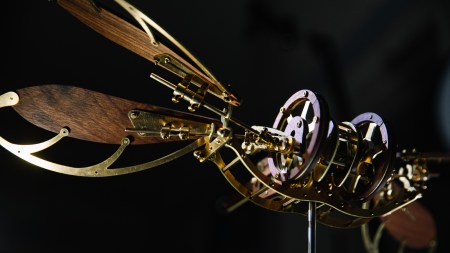
Show And Tell
Mechanical Dragonfly Automata Kit Build and Review
Time for a model kit build! This steampunk-inspired mechanic…






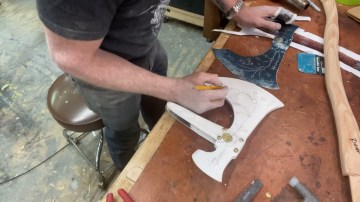
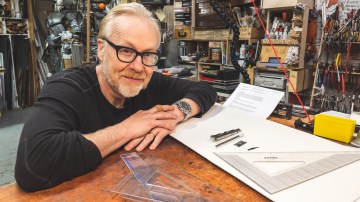
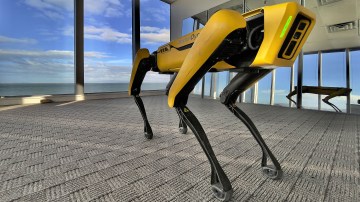
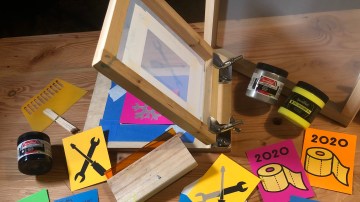
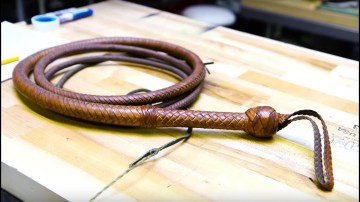
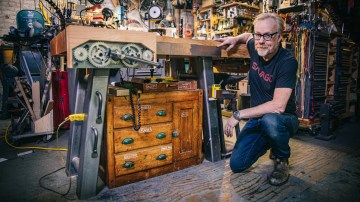
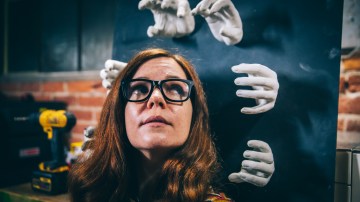

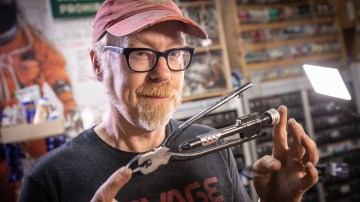
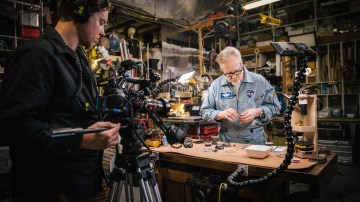
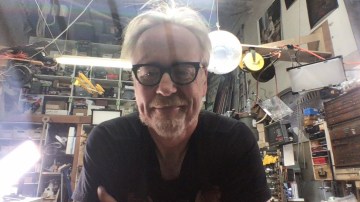

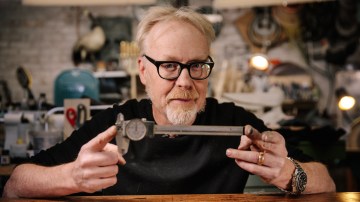
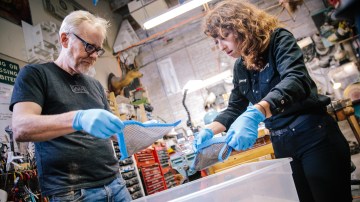
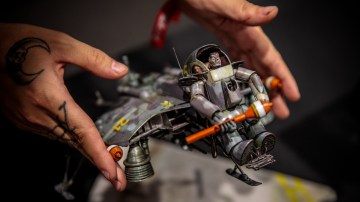
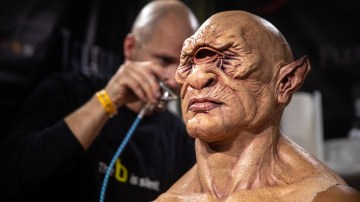

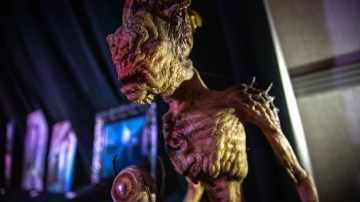
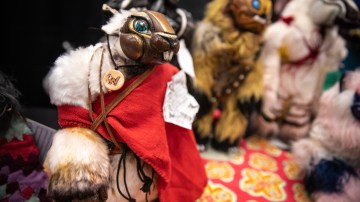

It would be cool if you post your WiP as a blog on Tested… Volpin Project update on one week and Bill Doran the other, that would be sweet, although video would be better,
shhhhh
I have been filming lots of video following my recent builds and will be editing them together very soon!
Gnnh! The Carnifex/Paladin and the Phalanx are my two favourite Mass Effect pistols. I want those! It’s impressive he does those with a scroll saw, the sanding must be insane.
Excellent stuff.
impressive.. this is professional stuff of a quality you’d expect to see from the stan winston institute or WETA